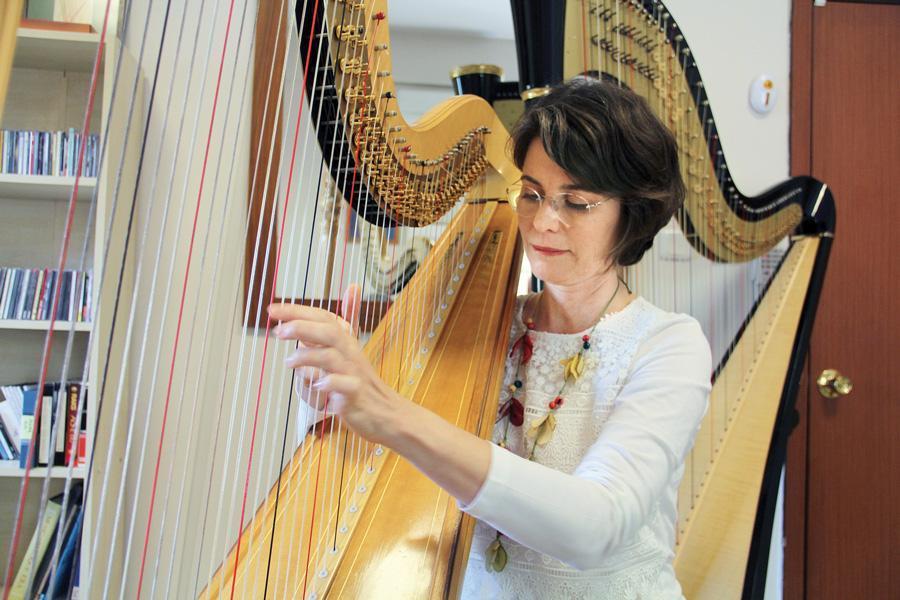
Turkey’s renowned harpist Şirin Pancaroğlu released her 12th album titled “Ab-ı Hayat” last month. The album, which consists of music commissioned by Hürrem Sultan for a Turkish bath in Hagia Sophia, presents her Ottoman-based compositions.
The album is accompanied by Bora Uymaz with his compositions, voice, and instruments.
Speaking to state-run Anadolu Agency, Pancaroğlu said one could inspired from many resources in making music.
The Turkish harpist said “music is not free from life itself.”
“Atatürk has a very important saying related to music, ‘music is not necessary in life because music is already life.’ The universe has music. NASA has recently measured it. There is a musical circle in space. It is very surprising. We have music inside of us, too. Our heart is beating; our pulse is like a rhythmic instrument. I believe music’s integration with life is very important,” she said.
Pancaroğlu said her projects have been based on people’s traditions and experiences.
“I do not do it only for social responsibility but music is in what we experience in life. One can mourn, cry, and think with music. It is possible to feel every mood. But today, our universities are not doing enough research on the scientific dimensions of traditional [Turkish] music,” she said.
Each composition is healing for a disease, she said.
“The world is going through pain. Our geography has many problems. Our country has to deal with many issues. We need a cure and music is a very good source for a cure,” said the harpist.
The harp has generally been believed to be a western instrument, said Pancaroğlu.
“The harp is actually one of the few instruments that does not have a homeland, since it is actually an instrument developed by hunting. Hunting does not have a homeland. In ancient times when people hunted for food with a bow and arrow, the sound of the arrow that pops from the bow was thought to be turned into an instrument by adding more than one wire,” she said.
“Just as rhythmic instruments are made from the skin of animals, the harp is a very primitive instrument, as old as human history. That is why it is adaptable to very different music,” said the harpist.
The çeng from Mesopotamia to the Ottoman
The çeng was a type of harp that existed in Mesopotamia and then in the Middle East, said Pancaroğlu, adding that it also had a spiritual meaning and had become a symbol in literary and visual culture.
She said it had a very important place in Ottoman culture and was played in palaces but disappeared after the 16th and 17th centuries.
“Over the last 10 years, I remade this lost instrument. There was no sample. I looked at old photos. I am living in this geography and want to protect this instrument. A local version can also be found in any other part of the world. Today, it has versions developed to be played in symphony orchestras. Technology was used to produce them,” she said.
Pancaroğlu began playing the harp at the age of 11 and has been playing it for nearly 40 years.
“I think children in Turkey need to study music more in schools. It is necessary to work on a pedagogical instrument for children. Last year, the Association of the Art of Harp made a prototype work. Now, we have to make pilot projects,” said the harpist.
She said they had designed an instrument for children to play both western and Turkish music.
“I believe every child deserves to play an instrument in school because it improves brain skills and calms the soul. When I am playing music, you listen to me. Maybe we do not have the same opinion but we find a common language. Music is a serious way of communication. It is as important as mathematics, social sciences, and physics. I will work hard to show this to people,” the musician said.
Anatolia has a rich heritage of civilizations and music, said Pancaroğlu.
“This heritage is so precious that the whole world has had their eye on this land. Our musical heritage is very fertile and productive but you cannot find support. It is a hard process to create something. We also have other problems. Cultural policies could not have been made in Turkey. If we can do it, no one can stop us,” she said.
The harpist also said they have been working on new projects, albums, publications and new performance methods at the Association of the Art of Harp, which they established 11 years ago.
She said she has gone beyond her dreams in music.
“I have mostly studied abroad. When I returned here, I saw a very different music culture. I was not able to read a musical note. I tried to learn a new music language after the age of 35. I did not even think of it,” Pancaroğlu said.